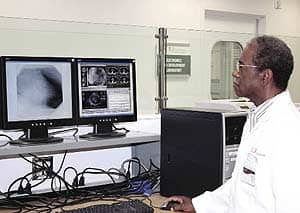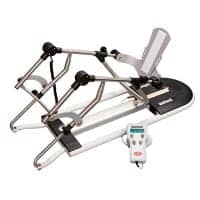What will it take for your organization to meet the requirements of the wireless environment? Beyond interference issues, we present some of the challenges you might be faced with and suggest ways in which you can meet them.

Hospitals worldwide are rolling out wireless networks to improve patient care by providing capabilities such as real-time access to patient data, computerized physician order entry, e-prescribing, bedside patient registration, and information on drug interactions and care protocols. Industry analysts estimate that more than half of all hospitals have installed wireless local area networks (WLANs) in at least one department. Analysts predict that half of all US-based physicians, primarily using continuous speed, handwriting recognition, and menu picks, will complete a substantial amount of their clinical documentation and order-entry tasks (primarily prescription writing and lab orders) on mobile devices.
When one combines the many wireless networks and devices (such as WLANs, PDAs, tablet PCs, mobile phones, pagers, etc) with other systems, both in and around the hospital, it’s easy to see that the potential for radio frequency interference (RFI) in the hospital is second to none. Yet, the increasing dependence upon wireless networks in health care leaves zero tolerance for failure.
The Medical Records Institute and Mobile Healthcare Alliance have acknowledged that the single largest impediment to the success of wireless health care is RFI. Interference can prohibit or delay the successful rollout of wireless networks. Interference can also cause equipment to malfunction, placing patients at an unnecessarily increased danger of harm.
Interference is an issue of risk and liability and can have debilitating effects across the entire hospital, including failure of medical telemetry systems carrying vital data on critically ill patients, critical wireless data backbone interruption, and failure or unpredictable operation of medical devices. Without considering the risks of interference, health care facilities are taking on a potentially critical liability.
It is important to know the designated frequencies of wireless networks and devices.
Radio Spectrum
Interference is a by-product of operation in the congested radio spectrum. When evaluating the interference potential from wireless networks and devices, it is important to know their designated frequencies within the radio spectrum and whether they share these frequencies with other services. Sharing of radio spectrum is an efficient use of a scarce resource, but sharing will also increase the potential for interference among devices.
Wireless medical telemetry (WMT) is an example of shared spectrum usage. Wireless telemetry devices can operate within any of five frequency bands (174 to 216 MHz, 450 to 668 MHz, 1395 to 1400 MHz, 1427 to 1432 MHz, and 2400 to 2500 MHz). Within these bands, frequencies can be shared with land mobile, paging, TV, WLANs, and even microwave ovens. Only three segments of these bands (608 to 614 MHz, 1395 to 1400 MHz, 1427 to 1432 MHz) are designated for exclusive use by the WMTs. Frequency use within these designated bands is coordinated so as to minimize the interference potential both from outside sources (such as TV) and from other WMT systems.
What is RFI?
Before we can fully understand the implications of the growing number of wireless devices in the hospital, it is important to understand what interference is and how to identify when it has occurred. The Federal Communications Commission (FCC) has defined harmful interference as “interference that endangers the functioning of radio communication service or seriously degrades, obstructs or repeatedly interrupts a radio communication service operating in accordance with these regulations.” Interference is further defined as “any emission, radiation, or induction, which specifically degrades, obstructs, or interrupts the service provided by such stations.”
There are two types of RFI: direct and indirect. Direct interference occurs when two systems operate on the same frequency channel or a nearby or adjacent channel. For example, multiple wireless fidelity systems within a hospital can interfere with one another since they share the same three channels. Indirect interference, often referred to as electromagnetic interference (EMI), occurs when RF radiation interferes with susceptible devices. For example, a cell phone may adversely affect the operation of an infusion pump because of EMI. Another type of indirect interference is intermodulation, which occurs when two or more frequencies combine to produce additional potentially interfering frequencies. Intermodulation is typically caused by multiple RF devices, such as antennas on a hospital rooftop, operating in close proximity.
There are also radiating devices in and around the hospital that can cause EMI to wireless devices. Examples include:
- fluorescent lights
- power distribution and switch gear
- microwave ovens
- building automation
- medical devices
- building alarm and monitoring
- MRI
- CT scanners
- x-ray
- TV and FM and AM broadcast stations
Once an interference problem is identified and the source of interference located, a hospital is faced with finding a solution that works for that particular application. Solutions may include frequency coordination, equipment shielding, equipment or antenna change, frequency relocation, equipment maintenance, power reduction, physical relocation, and disuse.
While there are many ways to fix interference problems, frequency coordination can untangle most of them. It is often the most effective solution, avoiding the problem before it starts. There are many technologies within the hospital, (eg, WMTs, land mobile, paging, cellular/PCS, wireless telecommunications, walkie-talkies, and WLANs) for which frequency coordination has been used to mitigate interference.
As a hospital’s RF environment becomes increasingly complex, it is imperative to select interference-free frequencies. Frequency coordination is based upon knowing the existing wireless environment and how wireless systems in one area of a hospital may affect those in another area. This can be accomplished through frequency inventory databases, RF measurements, or a combination of the two. To do this, the first step is to identify the types of networks and devices used within each of the key areas of a hospital.
There are numerous RF systems in hospitals that require RF and frequency engineering.
The Wireless Environment
There are numerous RF systems in hospitals that require both RF and frequency engineering. For instance, there are the typical rooftop antennas, including land mobile, paging, aeronautical (to talk with medevac helicopters), and even microwave and cellular/PCS. These antennas often operate with high power, thus increasing the potential for interference. Inside the hospital there are devices such as walkie-talkies, cell phones, paging systems, telemetry monitoring, nurse-call systems, building control (wireless environmental control), security systems, automation systems, wireless PBXs, WLANs for patient data, and medical equipment (MRI, CAT scans, x-ray, sonogram, RF scalpels, etc). It’s easy to see why the RF environment in a hospital is so complex.
Areas of high congestion may require closer scrutiny when compiling a wireless inventory. One example of this is the emergency room, which is often one of the busiest and most active wireless areas in the hospital. The ER may easily be affected by a complicated mix of practically every wireless device listed above.
When compiling a comprehensive database of all wireless devices in and around the hospital, RF frequency measurements can be very effective in identifying available frequencies and locating unexpected or unauthorized wireless activity throughout the hospital. RF measurements are often the only and most accurate way to locate interference sources. They can determine signal strength and pinpoint operating frequency, two key elements when determining interference potential. It is a good idea to repeat measurements at regular intervals throughout the year to maintain a current wireless device inventory. If your hospital does not have experience performing measurements, there are many outside firms that can provide this service.
Wireless LANs
Common wireless networks being deployed in hospitals are WLANs. They are typically used in hospitals for computer networks, e-health care networks, telemetry networks, PDA networking, asset tracking, personnel location, building automation, and security systems.
While WLANs provide a wide range of applications that allow users the increased mobility to wirelessly connect to a network, they are also susceptible to interference from other devices and from other WLANs sharing the same frequency band. These networks operate in the same band as microwave ovens and about 3,500 other FCC type–accepted devices, including cordless phones, Bluetooth devices, point-to-point microwave transmitters, and motion detectors to name a few. There is also a potential for multiple WLANs within a hospital to interfere with one another since there are only three channels available for interference avoidance. It’s no wonder the FCC calls this the “garbage band.”
Cell Phones
The use of cell phones in hospitals continues to be a controversial issue. The concern is that cell phones will interfere with patient dependent medical equipment. Therefore, cell phone usage is banned (or at least severely limited) in most hospitals. Close to 50% of the US population uses a cell phone, including most physicians, and when cell phone use is banned physicians and patients’ loved ones will find it difficult to remain in touch when immediate contact is critical.
In general, there are three types of cell phone policies in hospitals: 1) cell phone usage is banned throughout the hospital; 2) cell phone usage is limited to designated areas within the hospital; or 3) no cell phone policy is in place.
Hospitals that impose a strict cell phone policy find its enforcement challenging. Quite often, people will continue to use cell phones despite the hospital’s rules. Even with more lenient rules that limit cell phone usage to select areas within a hospital, this can pose an inconvenience, especially for physicians. Although the more progressive policies will allow some cell phone usage, any policy should balance the need for immediate contact with interference potential.
One solution to the interference potential posed by cell phones is to use a distributed in-building cellular repeater or distributed antenna system (DAS). Most cell phones have power control where the transmit power adjusts depending upon the strength of the signal received from the base station. Signal propagation through the building walls tends to weaken the base station signal, causing the cell phone to operate at higher power since it thinks the base station is farther away. A DAS effectively brings the cellular base station signal inside the building and better distributes it. By using a DAS, the phones will typically operate at a lower power, thus reducing the EMI potential.
Distributed antenna systems consist of a roof-mounted antenna that receives and transmits signal to the closest base station(s). Antennas within the building collect and redistribute signals to and from the cell phones. These systems can be deployed for a single wireless carrier or for multiple carriers. In addition, systems can be deployed and operated by a third party. These neutral host systems are often deployed in common spaces such as airports, shopping malls, and hospitals. The costs associated with installation of a DAS can vary depending on the complexity.
RF frequency measurements can be effective in identifying available frequencies.
Wireless Planning
Proper design, deployment, and use of wireless technologies require detailed planning and hospital-wide coordination. The first step to a successful wireless plan is to involve all wireless stakeholders in the hospital (eg, biomedical engineering, facilities management, and information technology) in comprehensive planning discussions. All stakeholders should work together using the following simple guidelines:
- Know the RF environment in and around the hospital. Develop an RF device/asset database that includes operating and susceptible frequencies. Become proficient at performing measurements, or bring in experts that can provide this service.
- Understand technologies and develop technology visions. Understand the impact of new technologies on existing systems. Wireless equipment vendors and service providers are a good source for this information.
- Develop frequency-coordination plans to harmonize the use of wireless frequencies and systems throughout the hospital.
- Develop and implement a proactive interference-management program to address future wireless needs.
- Coordinate wireless deployment strategies throughout the hospital. Some hospitals are hiring new staff whose primary function is to act as wireless managers. Responsibilities include developing wireless plans across the hospital and working to establish wireless task forces within the hospital to identify and coordinate wireless needs.
- Meet regularly and discuss wireless activities throughout the hospital.
- Get help. Outside firms specializing in wireless technologies and engineering can provide specialized expertise such as training, consulting, and deployment support. You don’t have to go it alone.
Conclusion
Wireless systems in hospitals are becoming ubiquitous. To complicate matters further, wireless devices and networks operate over a wide range of frequencies in the radio spectrum, often sharing their spectrum with other devices and networks. The potential for RF interference is great. Indeed, in most situations, debilitating interference is not a matter of if but when. Hospitals can take steps to address and mitigate this threat. With proper and proactive wireless planning by all wireless stakeholders based on a set of simple, yet sound guidelines, hospitals can ensure robust and interference-free wireless deployments facility-wide. While wireless technologies are revolutionizing health care, proper management of the RF environment will ensure that the revolution proceeds unhindered.
Laura Fontaine is director, spectrum management at Comsearch, Ashburn, Va.







